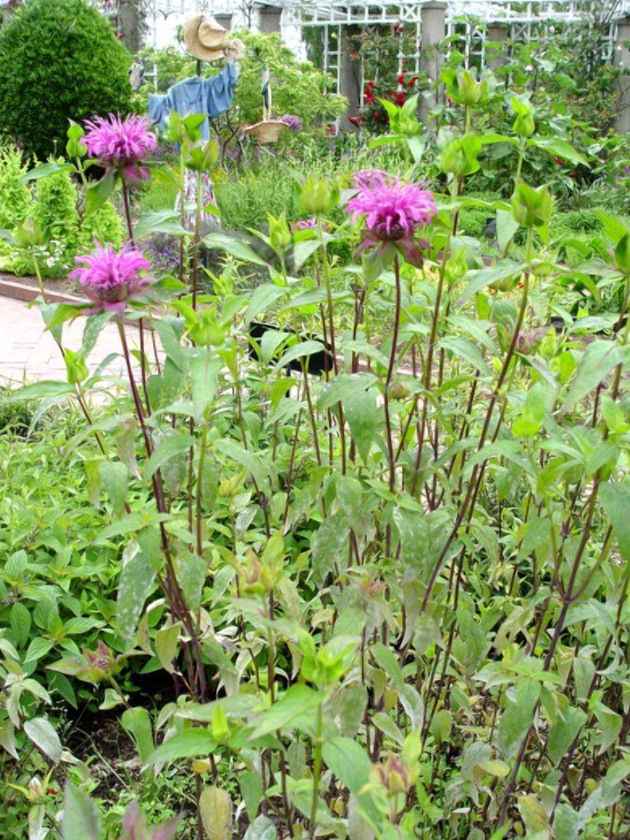

On the head will be tubular flowers that are in rings, and will arc or bend down. The flower head of Bee Balm will be about 2-4″ diameter. Bee Balm blooming duration can be prolonged with deadheading Bee Balm Flowerīee Balm flowering time will be late Spring to early Summer with blooms lasting for about 4 weeks. Deeply veined with serrated edges, the leaves are generally dark green but will have red or purple shades on them. Leaves of Bee Balm are opposite along the stem, 4-5″ long by 2″ wide, and ovate in shape.
Bee balm plant information full#
In full sun and competition the plant can reach 4-5′ tall. The stem will be light green in appearance and slightly hairy to smooth. Bee Balm Stalk / StemĪs a member of the mint family, Bee Balm will have a 4-sided or square stem. So you can keep Bee Balm coming back year after year since it is a perennial. Naturally clump forming, it’s natural habitat is open woodlands and along streams, as it prefers moist to medium soil with lots of organic matter.Īnd Bee Balm has cold tolerance and is frost hardy. Bee Balm Characteristics and Identificationīee Balm is a perennial that will grow between 2-4′ tall depending on conditions. Hence another common name for it – Oswego Tea! Both leaves and flowers can be used medicinally. Bee Balm is medicinal!įrom the Native Americans to modern times, herbalists use Bee Balm to medicinally. The late Spring to early Summer window is often devoid of color! Most homes have early Spring Bulbs, but then are a flower desert until Summer sets in and their roses and perennials take off! You can use Scarlet Bee Balm to bridge the blooming gap. Need some other flowers that grow well in clay? Click here Bee Balm blooms when most other plants are not blooming! Many people spend years fighting clay soil rather than selecting plants that thrive in it! The clay helps retain moisture which is necessary for the Red Bee Balm to survive. You can easily grow Bee Balm in clay soil. Credit Linda Carlsen Sperry Monarda didyma grows well in clay soil Studies have shown that it is mainly pollinated by hummingbirds, as they are the most frequent visitor. Longer if you deadhead! Hummingbirds LOVE Bee Balmīee Balm and Hummingbirds are almost always found together! For native perennials, there is probably no other plant that attracts as many ruby throated hummingbirds as red Bee Balm. The primary benefit is by far the beauty you will bring to your yard! The prominent red blooms can give your gardens a stunning red show for a month. There are many benefits of growing Monarda didyma. What is Bee Balm good for? Bee Balm is beautiful Or, some people will also just refer to it as “Monarda”, which is the genus the plant belongs to.īut, if you are interested in reading more on the beautiful Red Bee Balm, continue! Reference Table Scientific Nameīee Balm, Scarlet Bee Balm, Oswego Tea, Jacob Cline Bee Balm, Red Bee BalmĮastern United States, Mid-Atlantic & New England, USDA Zone 4-9 Other names of Bee Balm include Scarlet Bee Balm, Jacob Cline Bee Balm, Red Bee Balm, and Oswego Tea. Commonly known as Bee Balm, it will grow 2-4 feet tall in full sun and well drained soil under moist-to-medium soil conditions. Monarda didyma is a perennial wildflower native to North America that blooms bright red blooms for a month in late Spring to early Summer, and is primarily pollinated by hummingbirds. What is Scarlet Bee Balm (Monarda didyma)
Bee balm plant information how to#

What are the benefits of Monarda Didyma.From her on out I will refer to it as ‘Bee Balm’ to keep things simple.īut if you would like a broad overview of the different flowers that get labeled, “Bee Balm”, then click hereto read our guide to all members of the Monarda genus! This article will only cover the red Bee Balm, Monarda didyma. That’s OK! Unfortunately the common name “Bee Balm” gets applied to several members of the Monarda genus. If you have been researching Bee Balm on the internet, you may be feeling a bit confused. So, stick around and I will tell you all you need to know to grow this wonderful, true hummingbird magnet! Monarda didyma, Scarlet Bee Balm I’ve grown dozens of this plant over the last 7 years and have become very skilled at growing, caring for, and propagating it through several means. Commonly known as Bee Balm (and many other names), this wildflower is primarily pollinated by hummingbirds. If you want to attract Hummingbirds to your garden, there is probably no other plant that can reliably do so than Monarda didyma.


 0 kommentar(er)
0 kommentar(er)
